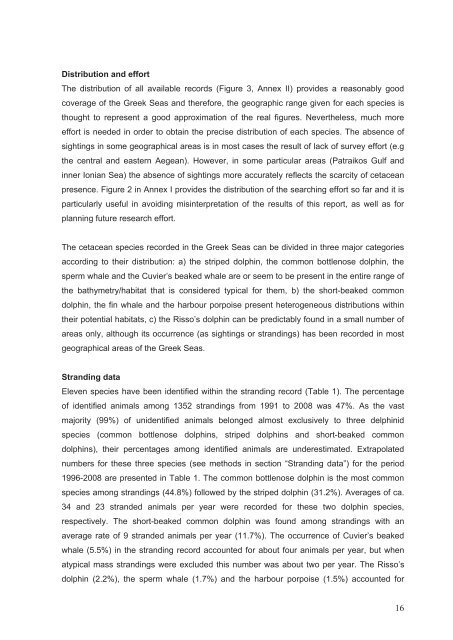Cetaceans in Greece: Present status of knowledge
Cetaceans in Greece: Present status of knowledge
Cetaceans in Greece: Present status of knowledge
Create successful ePaper yourself
Turn your PDF publications into a flip-book with our unique Google optimized e-Paper software.
Distribution and effort<br />
The distribution <strong>of</strong> all available records (Figure 3, Annex II) provides a reasonably good<br />
coverage <strong>of</strong> the Greek Seas and therefore, the geographic range given for each species is<br />
thought to represent a good approximation <strong>of</strong> the real figures. Nevertheless, much more<br />
effort is needed <strong>in</strong> order to obta<strong>in</strong> the precise distribution <strong>of</strong> each species. The absence <strong>of</strong><br />
sight<strong>in</strong>gs <strong>in</strong> some geographical areas is <strong>in</strong> most cases the result <strong>of</strong> lack <strong>of</strong> survey effort (e.g<br />
the central and eastern Aegean). However, <strong>in</strong> some particular areas (Patraikos Gulf and<br />
<strong>in</strong>ner Ionian Sea) the absence <strong>of</strong> sight<strong>in</strong>gs more accurately reflects the scarcity <strong>of</strong> cetacean<br />
presence. Figure 2 <strong>in</strong> Annex I provides the distribution <strong>of</strong> the search<strong>in</strong>g effort so far and it is<br />
particularly useful <strong>in</strong> avoid<strong>in</strong>g mis<strong>in</strong>terpretation <strong>of</strong> the results <strong>of</strong> this report, as well as for<br />
plann<strong>in</strong>g future research effort.<br />
The cetacean species recorded <strong>in</strong> the Greek Seas can be divided <strong>in</strong> three major categories<br />
accord<strong>in</strong>g to their distribution: a) the striped dolph<strong>in</strong>, the common bottlenose dolph<strong>in</strong>, the<br />
sperm whale and the Cuvier’s beaked whale are or seem to be present <strong>in</strong> the entire range <strong>of</strong><br />
the bathymetry/habitat that is considered typical for them, b) the short-beaked common<br />
dolph<strong>in</strong>, the f<strong>in</strong> whale and the harbour porpoise present heterogeneous distributions with<strong>in</strong><br />
their potential habitats, c) the Risso’s dolph<strong>in</strong> can be predictably found <strong>in</strong> a small number <strong>of</strong><br />
areas only, although its occurrence (as sight<strong>in</strong>gs or strand<strong>in</strong>gs) has been recorded <strong>in</strong> most<br />
geographical areas <strong>of</strong> the Greek Seas.<br />
Strand<strong>in</strong>g data<br />
Eleven species have been identified with<strong>in</strong> the strand<strong>in</strong>g record (Table 1). The percentage<br />
<strong>of</strong> identified animals among 1352 strand<strong>in</strong>gs from 1991 to 2008 was 47%. As the vast<br />
majority (99%) <strong>of</strong> unidentified animals belonged almost exclusively to three delph<strong>in</strong>id<br />
species (common bottlenose dolph<strong>in</strong>s, striped dolph<strong>in</strong>s and short-beaked common<br />
dolph<strong>in</strong>s), their percentages among identified animals are underestimated. Extrapolated<br />
numbers for these three species (see methods <strong>in</strong> section “Strand<strong>in</strong>g data”) for the period<br />
1996-2008 are presented <strong>in</strong> Table 1. The common bottlenose dolph<strong>in</strong> is the most common<br />
species among strand<strong>in</strong>gs (44.8%) followed by the striped dolph<strong>in</strong> (31.2%). Averages <strong>of</strong> ca.<br />
34 and 23 stranded animals per year were recorded for these two dolph<strong>in</strong> species,<br />
respectively. The short-beaked common dolph<strong>in</strong> was found among strand<strong>in</strong>gs with an<br />
average rate <strong>of</strong> 9 stranded animals per year (11.7%). The occurrence <strong>of</strong> Cuvier’s beaked<br />
whale (5.5%) <strong>in</strong> the strand<strong>in</strong>g record accounted for about four animals per year, but when<br />
atypical mass strand<strong>in</strong>gs were excluded this number was about two per year. The Risso’s<br />
dolph<strong>in</strong> (2.2%), the sperm whale (1.7%) and the harbour porpoise (1.5%) accounted for<br />
16


